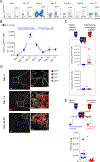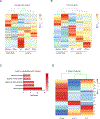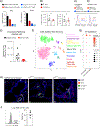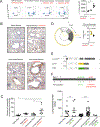Effector TH17 Cells Give Rise to Long-Lived TRM Cells that Are Essential for an Immediate Response against Bacterial Infection
- PMID: 31442406
- PMCID: PMC7057720
- DOI: 10.1016/j.cell.2019.07.032
Effector TH17 Cells Give Rise to Long-Lived TRM Cells that Are Essential for an Immediate Response against Bacterial Infection
Abstract
Adaptive immunity provides life-long protection by generating central and effector memory T cells and the most recently described tissue resident memory T (TRM) cells. However, the cellular origin of CD4 TRM cells and their contribution to host defense remain elusive. Using IL-17A tracking-fate mouse models, we found that a significant fraction of lung CD4 TRM cells derive from IL-17A-producing effector (TH17) cells following immunization with heat-killed Klebsiella pneumonia (Kp). These exTH17 TRM cells are maintained in the lung by IL-7, produced by lymphatic endothelial cells. During a memory response, neither antibodies, γδ T cells, nor circulatory T cells are sufficient for the rapid host defense required to eliminate Kp. Conversely, using parabiosis and depletion studies, we demonstrated that exTH17 TRM cells play an important role in bacterial clearance. Thus, we delineate the origin and function of airway CD4 TRM cells during bacterial infection, offering novel strategies for targeted vaccine design.
Keywords: Fate mapping; IL-17; IL-7; T(H)17; Tissue resident memory CD4 T cells; exT(H)17.
Copyright © 2019 Elsevier Inc. All rights reserved.
Conflict of interest statement
Declaration of Interests
The authors declare no competing interests
Figures





References
-
- Becattini S, Latorre D, Mele F, Foglierini M, De Gregorio C, Cassotta A, Fernandez B, Kelderman S, Schumacher TN, Corti D, Lanzavecchia A and Sallusto F (2015). “T cell immunity. Functional heterogeneity of human memory CD4(+) T cell clones primed by pathogens or vaccines.” Science 347(6220): 400–406. - PubMed
-
- Carlson CM, Endrizzi BT, Wu J, Ding X, Weinreich MA, Walsh ER, Wani MA, Lingrel JB, Hogquist KA and Jameson SC (2006). “Kruppel-like factor 2 regulates thymocyte and T-cell migration.” Nature 442(7100): 299–302. - PubMed
Publication types
MeSH terms
Substances
Grants and funding
LinkOut - more resources
Full Text Sources
Other Literature Sources
Molecular Biology Databases
Research Materials

